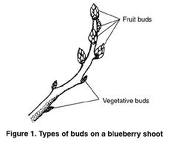Pruning Blueberries
 Blueberries produce fruit on 1‐year‐old wood (last year’s growth). Fruit buds are visible during the dormant season. They are the fat buds at the tip of last year’s growth. The small, scale‐like buds toward the base of the 1‐year‐old wood are vegetative buds; they will produce a shoot with leaves next season.
Blueberries produce fruit on 1‐year‐old wood (last year’s growth). Fruit buds are visible during the dormant season. They are the fat buds at the tip of last year’s growth. The small, scale‐like buds toward the base of the 1‐year‐old wood are vegetative buds; they will produce a shoot with leaves next season.
After the third year, you need to prune blueberry plants every winter. The best time to prune is January to early March, when plants are dormant.
When pruning blueberries you should be using a bypass hand pruner.
The main objectives of pruning are to promote the growth of strong, new wood and to maintain good fruit production. If you prune too little, plants produce too many small berries and shoot growth is weak. Plants have weak, twiggy growth at the end of the season and fail to develop strong new wood for future production. Severe pruning pro‐ duces fewer, larger berries and more new wood.
When pruning, keep in mind the following principles.
Keep the bush fairly open. Open bushes pro‐ mote better air circulation (less disease) and good light penetration to improve fruit bud set for next year’s crop.
Mature bushes should have 6 to 12 canes at their base, depending on cultivar or growth habit. After pruning, there generally should be 6
Some cultivars do not produce many whips from the base of the plant. Instead they produce whips from the base of older canes between ground level to knee height. When you prune these bushes, you will have fewer canes at the base of the plant, but more new growth or renewal wood higher up on the bush.
The following step-by-step system will make pruning easier.
1. Cut out any wood that’s dead, damaged, or
2. Remove whips smaller than pencil size in diameter, but leave larger whips to develop into good fruiting wood next year.
3. Cut out one or two old, unproductive canes (large stems arising near the base of the plant). Fourth‐year or older wood with small, weak growth (short laterals or 1‐year‐wood) is unproductive. Cut these canes back to the ground or to a strong new whip growing near the base.
4. Remove excess whips (or “suckers”) and weak, twiggy wood, especially from the top of the plant, to allow light to reach the center.
5. Plants may overbear. This often results in very little new growth of wood and small, late‐ maturing berries. If this is a problem, remove some of the weakest (thin and short) 1‐year‐old wood. If necessary, also tip back some of the remaining long 1‐year‐old wood by cutting off about one-third of the flower buds.

